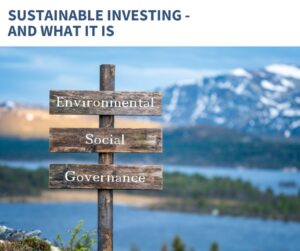By Nick Ziarek CFP®, CFA
Sustainable Investing Today
More and more, returns are no longer the only driver that investors look for when making their investment decisions. Among the hottest trends in the markets today is sustainable investing. This is driven by investors following a values-based philosophy of wanting to do better by being better.
According to Morningstar, the category of sustainable funds pulled in 25% of all net U.S. equity fund flows for 2020, which totaled $51.1 billion. This represented a 144% increase over 2019 and nearly 850% increase over the $5.4 billion invested in 2018. [1]
ESG, Socially Responsible Investing, and Impact Investing
Often the terms sustainable investing, ESG (environmental, social, and governance), socially responsible investing and impact investing are used interchangeably. However, there are significant differences in each style that can lead to vastly different portfolio holdings and performance.
Think of sustainable investing as the umbrella under which ESG, socially responsible investing and impact investing reside. On the base level, each method intends to align an investor’s principles with the companies or projects in which they invest.
ESG is the most common and popular strategy of sustainable investing. The focus of ESG investing is on how companies handle issues ranging from climate change and pollution to community engagement, labor practices, boardroom diversity and shareholder rights, to name a few.
ESG scores are compiled by ranking companies in various categories based on environmental, social, and governance measures, then weighting those results. A challenge in the industry is that there is little consensus to how companies should be scored or which categories should have a greater weighting. Rapid growth in the sector has led to varying levels of art and science when it comes to rating individual companies.
For example, Telsa is rated significantly different by each of the three major rating agencies. MSCI gives Tesla an A-rating while S&P Global rates them B- and Sustainalytics labels them High Risk. There are other examples including Philip Morris which was recently added to the Dow Jones Sustainability Index despite producing hundreds of billions of highly addictive cigarettes each year. Consider, should Exxon Mobil and BP be excluded for their negative impact from fossil fuels or should they be included because of the significant sums of money they are investing in green resources and trying to shrink their carbon footprint? And then you have technology companies like Amazon and Apple which have all positioned themselves to be green and forward thinking but deal with increasingly negative labor practices.
Socially responsible investing has been around for a much longer time and involves screening investments and sectors to exclude businesses that don’t align with an investor’s values. The most frequent exclusion is sin stocks such as gambling, alcohol, tobacco, and firearms. This has since evolved to include industries such as oil and gas companies.
Impact investing typically involves a direct connection between the investor’s capital and the investment itself. The investments are specific and targeted. Success is not measured by financial performance alone, but by quantifiable targets such as number of rainforest acres saved, tons of carbon emissions reduced, or schools built.
As one can see, sustainable investing is more of an art than a science. What matters most is an investor’s values. When considering an investment for your portfolio, be sure to have a solid understanding of your values, how you want those to align with underlying investments, and whether the investment vehicle you choose follows those same principles.
[1] https://www.morningstar.com/articles/1019195/a-broken-record-flows-for-us-sustainable-funds-again-reach-new-heights